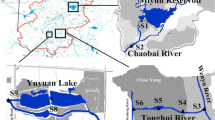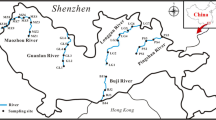Abstract
The Grand Canal is one of the most important waterways and sources of drinking water in China. The security of this water environment has a strong influence on national economic development and public health. However, data on the pollution status and potential risks due to persistent organic pollutants (POPs) in this area is insufficient. In this study, we selected a branch of the Grand Canal in Hangzhou as the study subject from which 16 surface water samples were collected in the summer of 2016. The concentrations of organochlorine pesticides (OCPs) (including 4 hexachlorocyclohexanes (HCHs) and 6 dichlorodiphenyltrichloroethanes (DDTs)), 12 polycyclic aromatic hydrocarbons (PAHs), and 35 polychlorinated biphenyls (PCBs) in the water samples were determined by gas chromatography–mass spectrometry (GC-MS). Non-carcinogenic risk, carcinogenic risk, and cytotoxicity experiments were conducted to evaluate the potential health risks due to these POPs. Additionally, the toxicological data for the Danio rerio aquatic organism from the US EPA were employed for comparison with the residue from POPs in this area. The results showed that the total concentrations of HCHs, DDTs, PCBs, and PAHs were 29.937, 60.2, 8.30, and 1670.2 ng/L, respectively. Some pollutants (including acenaphthene and acenaphthylene, hepta-PCBs and tetra-PCBs, octa-PCBs and hexa-PCBs, β-HCH and α-HCH, and δ-HCH and γ-HCH) showed a correlation, which indicated they might have a similar origin. There were no non-carcinogenic risks or ecological risks for adults, children, and aquatic organisms, but a relatively low carcinogenic risk for adults presented at certain sites. The data provided here will be helpful in fully understanding the pollution status of the surface water in this branch of the Grand Canal and the potential risks from this water.

ᅟ





Similar content being viewed by others
References
Cao, Z., Wang, Y., Ma, Y., Xu, Z., Shi, G., Zhuang, Y., & Zhu, T. (2005). Occurrence and distribution of polycyclic aromatic hydrocarbons in reclaimed water and surface water of Tianjin, China. Journal of Hazardous Materials, A122, 51–59.
Chen, Y. X., Liu, H., Zhu, G. W., & Chen, H. L. (2004). Pollution characteristics of the recent sediments in the Hangzhou section of the Grand Canal, China. Journal of Environmental Science, 16, 34–39.
Chen, H., Zhu, J. Q., Li, Z., Chen, A., & Zhang, Q. (2016). The occurrence and risk assessment of five organophosphorus pesticides in river water from Shangyu, China. Environmental Monitoring and Assessment, 188(11), 614.
E.U. 98/83/EC (2014). The European Union drinking water regulations. Council Directive 98/83/EC (European Commission, 1998).
GB3838 (2002). China environmental quality standards for surface water.
GB5749 (2006). National standards for drinking water quality.
Guo, Y. (2007). Detection and ecological impact evaluation of persistent toxic substances in Shantou—a typical area with e-waste recycling. Doctoral Dissertation (Shantou University). 74–138.
Guo, J., & Fang, J. (2012). The distribution of n-alkanes and polycyclic aromatic hydrocarbons in water of Taihu Lake. Procedia Environmental Sciences, 12, 258–264.
Guo, F., Wang, L., & Wang, W. X. (2012). Acute and chronic toxicity of polychlorinated biphenyl 126 to Tigriopusjaponicus: effects on survival, growth, reproduction and intrinsic rate of population growth. Environmental Toxicology Chemistry, 31, 639–645.
Han, D. M., & Matthew, J. C. (2017). Persistent organic pollutants in China’s surface water systems. Science of the Total Environment, 580, 602–625.
He, W., Qin, N., He, Q. S., Wang, Y., Kong, X. Z., & Xu, F. L. (2012). Evaluation of the hazard quotient method for risk assessment of selenium characterization, ecological and health risks of DDTs and HCHs in water from a large shallow Chinese lake. Ecological Information, 12(12), 77–84.
Lemly, A. D. (1996). Evaluation of the hazard quotient method for risk assessment of selenium. Ecotoxicology and Environment Safety, 35(2), 156–162.
Li, G. Z., Wang, X. (2011). Distribution feature of heavy metals in bottom sediments of Beijing-Hangzhou Grand Canal. 2011 International Conference on Remote Sensing, Environment and Transportation Engineering (RSETE 2011). pp. 240–242.
Li, Q., Zeng, Y., Fan, Y. Q., & Liu, X. Y. (2006). Distribution of polycyclic aromatic hydrocarbons (PAHs) in Lanzhou reach of the Yellow River. Chinese Journal of Health Laboratory Technology, 16(9), 1108–1109.
Li, Z. G., Han, B. Q., Ge, D. M., & Sun, Y. (2007). Studies on the relations between morphological distribution of heavy metals and organic carbon in bottom sediment in Beijing-Hanzhou Grand Canal (Xuzhou section). Journal of Anhui Agricultural Science, 35, 3944–3945.
Lu, C. S., Chang, C. H., Palmer, C., Zhao, M. R., Zhang, Q. (2018). Neonicotinoids residues in fruits and vegetables: An integrated dietary exposure assessment approach. Environmental Science & Technology. https://doi.org/10.1021/acs.est.7b05596.
McAuliffe, M. E., Williams, P. L., Korrick, S. A., Altshul, L. M., & Perry, M. J. (2012). Environmental exposure to polychlorinated biphenyls and p, p’-DDE and sperm sex-chromosome disomy. Environmental Health Perspectives, 120, 535–540.
Mujtaba, B., Sadef, Y., Ahmad, S. R., Mahmood, A., QadirIqra, A., Aslam, J. L., & Zhang, G. (2017). Occurrence, ecological risk assessment, and spatio-temporal variation of polychlorinated biphenyls (PCBs) in water and sediments along River Ravi and its northern tributaries, Pakistan. Environmental Science and Pollution Research, 24(36), 27913–27930.
Nomiyama, K., Yonehara, T., Yonemura, S., Yamamoto, M., Koriyama, C., Akiba, S., Shinohara, R., & Koga, M. (2011). Determination and characterization of hydroxylated polychlorinated biphenyls (OH-PCBs) in serum and adipose tissue of Japanese women diagnosed with breast cancer. Environmental Science and Technology, 44, 2890–2896.
Pliskova, M., Vondracek, J., Canton, R. F., Nera, J., Kocan, A., Petrik, J., Trnovec, T., Sanderson, T., van den Berg, M., & Machala, M. (2005). Impact of polychlorinated biphenyls contamination on estrogenic activity in human male serum. Environmental Health Perspectives, 113, 1277–1284.
Sun, X. F., Han, B. P. (2011). The distribution features and ecological risk evaluation of PCBs in the surface sediments of the Grand Canal (Xuzhou section). 2011 International Conference on Electric Technology and Civil Engineering (ICETCE). pp. 4609–4611.
U.S. EPA. (2016). National recommended water quality criteria—aquatic life criteria table. Washington, DC: Office of water U.S. environmental protection agency.
Unyimadu, J. P., Osibanjo, O., & Babayemi, J. O. (2017). Polychlorinated biphenyls (PCBs) in River Niger, Nigeria: occurrence, distribution and composition profiles. Toxicology and Industrial Health, 34(8), 54–67.
Wang, X. L., Han, J. Y., Xu, L. G., & Zhang, Q. (2010). Spatial and seasonal variations of the contamination within water body of the Grand Canal, China. Environmental Pollution, 158, 1513–1520.
WHO. (2011). Guidelines for drinking-water quality. Fourth edition world health organization. Geneva: Switzerland.
Xiang, W., Han, B. P., & Xu, A. Q. (2009). Residual state of organochlorine pesticides in surface samples of sediments from Beijing-Hangzhou Grand Canal (Tongshan Xuzhou section). Journal of Agro-Environment Science, 28, 2151–2154.
Yang, Q., Ou, S., Xie, P., Mai, B., Fu, J., & Sheng, G. (2004). Distribution and seasonal changes of polycyclic aromatic hydrocarbons (PAHs) in surface water from Humen tidal channel. Acta Oceanologica Sinica, 26(6), 37–48.
Yao, T., He, C., Zhang, P., Gao, H., & Zhou, C. (2013). Distribution and sources of polychlorinated biphenyls (PCBs) and organochlorine pesticides (OCPs) in surface waters of Jinzhou Bay in China. Procedia Environmental Sciences, 18, 317–322.
Yu, G. B., Liu, Y., Yu, S., & Li, G. L. (2011). Enrichment and potential ecological risk assessment of heavy metals in surface sediment from urban sections along the Grand Canal of China. Environmental Chemistry, 30(11), 1906–1911.
Zhang, Z., Huang, J., Yu, G., & Hong, H. (2004). Occurrence of PAHs, PCBs and organochlorine pesticides in the Tonghui River of Beijing, China. Environmental Pollution, 130, 249–261.
Zhang, Q., Ye, J. J., Chen, J. Y., Xu, H. J., Wang, C., & Zhao, M. R. (2014). Risk assessment of polychlorinated biphenyls and heavy metals in soils of an abandoned e-waste site in China. Environmental Pollution, 185, 258–265.
Zhang, Q., Li, Z., Chang, C. H., Lou, J. L., Zhao, M. R., & Lu, C. S. (2018). Potential human exposures to neonicotinoid insecticides: A review. Environmental pollution, 236, 71–81.
Zhang, Q., Zhu, J. Q., Ye, J. J., Qian, Y., Chen, F., Wang, J. H., & Zhao, M. R. (2015). Temporal trends and risk assessment of polychlorinated biphenyls and heavy metals in a solid waste site in Taizhou, China. Environmental Science and Pollution Research, 23(1), 1–9.
Zheng, X., Wen, H. Y., Han, B. P., & Ge, D. M. (2011). Content analysis and assessment of polycyclic aromatic hydrocarbons in surface sediments of Beijing-Hangzhou Grand Canal (Yangzhou section). Environmental Monitoring in China, 27(4), 66–70.
Zheng, X., Han, B. P., Thavamani, P., Duan, L. C., & Naidu, R. (2015). Composition, source identification and ecological risk assessment of polycyclic aromatic hydrocarbons in surface sediments of the Subei Grand Canal, China. Environmental Earth Sciences, 74(3), 2669–2677.
Funding
This study was funded by the National Natural Science Foundation of China (21777147, 21677130, and 21577129).
Author information
Authors and Affiliations
Corresponding author
Electronic supplementary material
ESM 1
(DOC 499 kb)
Rights and permissions
About this article
Cite this article
Zhang, Q., Wang, X., Zhu, J. et al. Occurrence and risk assessment of persistent organic pollutants in a branch of the Grand Canal in Hangzhou, China. Environ Monit Assess 190, 211 (2018). https://doi.org/10.1007/s10661-018-6572-z
Received:
Accepted:
Published:
DOI: https://doi.org/10.1007/s10661-018-6572-z




